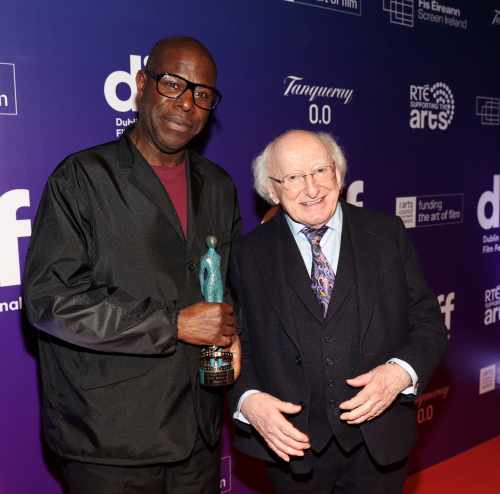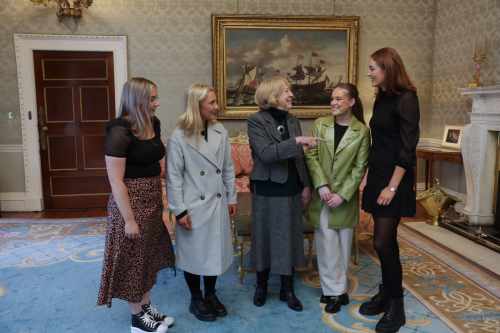Opening Words by Sabina Higgins at an Auction for Médecins Sans Frontières in Gaza
Copperhouse Art Gallery, 29th February, 2024
Friends,
I am delighted to be here with you all this evening, and to have the opportunity of welcoming you all to this special event, an auction in aid of Médecins Sans Frontières and Gaza.
May I thank Rosita Sweetman and Constance Short for their invitation to me to be with you this evening, and thank too Leszek Wolnak who is kindly hosting us here in the Copperhouse.
This evening we gather not only as appreciators of art, beauty and creativity, and in celebration and recognition of those who provide it, create it and donate, but as advocates for peace and humanity in a world torn apart by conflict. This is one of the bad times in history.
We cannot and must not avert our gaze from Gaza.
From the horrific scenes of loss of life and destruction of life and the means of life - 30,000 killed, two thirds of them women and children, 70,000 injured and the hundreds of thousands starving. Children dying in bombarded hospitals for lack of oxygen, bombardment and targeting of civilian infrastructure, schools levelled, hospitals in smoke, bakeries destroyed.
Palestinians having been forced by Israel to vacate Northern Gaza at 24 hours’ notice, and having fled South without food or water are now waiting in terror of a ground invasion in Rafah – a tented refugee city, normally of a population of 250,000, where 1.5 million displaced Palestinians are now densely crowded in. There is extreme human suffering, be it from lack of food and water, poor sanitation and increasing suffering from disease, and, now recognised by all, the looming danger of famine.
Humanitarian agencies are not able to operate at a third of the need, and aid convoys are being hit. Today’s news tells of over a hundred killed with numbers rising and hundreds injured as they approached aid trucks. People everywhere are scandalised at Israel’s ignoring global calls for a ceasefire and for their not allowing humanitarian aid into Gaza.
The Secretary-General of the United Nations, speaking recently at the Human Rights Council has repeated his statement that nothing justifies the collective punishment of the Palestinian people. He said he had to envoke Article 99 for the first time in his mandate to put the greatest possible pressure on the council to do everything in its power to end the bloodshed in Gaza and prevent escalation but, he decried the response saying that it was not enough. International humanitarian law remains under attack.The recommendations of the International Court of Justice are being ignored by Israel and its supporters.
The United Nations itself is under attack as is it main agency for refugee welfare, UNRWA – The United Nations Relief and Works Agency that is crucial for Palestinian refugees, as an essential part of the humanitarian aid operation in Rafah. It is the main support of more than a million and a half Palestinian civilians sheltering there.
The UN and so many others have called on countries who have cancelled aid to UNRWA to revoke that decision. How can the representatives of those countries look on as young infants struggle to survive – infants whose lives could be saved by having such basics as bread and clean water. Young children in particular are heavily at risk and needing bread and clean water. Philippe Lazzarini, Commissioner- General of UNRWA has stated that what is happening in Gaza is a man-made disaster and that famine can be avoided if there is genuine political will to grant access and protection to the delivery of meaningful assistance.
Amidst the harrowing scenes in Gaza, one outstanding beacon of hope that has remained constant is the unwavering commitment of groups like Médecins Sans Frontières, those brave doctors and medical personnel who provide life-saving medical care in impossible, heartbreaking circumstances, in hospitals under fire, forced to operate on desperate people without anesthetic or essential equipment, all too often targeted or detained themselves by Israeli forces. That is who the funds raised by this exhibition will be supporting.
And it is appropriate that it is artists who are driving this initiative of solidarity, because one of the other few points of light in these dark times has been the strength and resilience of Palestinian culture and the bravery shown by Gaza’s artists and storytellers.
Precisely because of its power, that culture has been consistently attacked by Israeli forces. And amidst so many terrible war crimes, it is important to recognise that to seek to destroy the means of life and culture of a people is also a war crime.
The fact that Israeli Government “has damaged and destroyed numerous centres of Palestinian learning and culture” is one of the grounds highlighted by South Africa in the genocide case they have brought against Israel at the International Court of Justice.
Two hundred sites of deep historical and heritage importance have already been destroyed by Israeli air strikes. These include an ancient harbour from 800 BC; one of the oldest Christian Monasteries in the world, and Gaza’s Great Omari Mosque:- The ancient collection of manuscripts kept at the mosque remain inaccessible and potentially lost forever because of the continuing conflict.
All of Gaza’s universities have also been hit, and the Al-Issa University and its museum of over 3,000 precious cultural artifacts have been demolished with explosives.
But culture is not just what is tangible – the buildings and the ground. Culture also includes the intangible, the shared experience of people living together and moving through the world.
The ritual of sharing a meal: the rites of burying your dead become impossible to practice when your dead are lost beneath rubble and there is only animal feed and saltwater to share as food. Israel has bombed almost all of the bakeries, and held back life-saving humanitarian aid, even as children starve.
It is not surprising that this killing has also targeted storytellers. Keepers of the narrative of this war – 122 journalists have died. The war has led to the killing of artists and writers and poets - Historian Isber Sabrine has highlighted how attacks on culture go against the Hague convention, “Israel is trying to erase the connection of the people with their land. It’s very clear and intentional. Gaza’s heritage is part of its people, it’s history and their connection”.
Alexandra Meargau has described how “the wars in Gaza have aimed at creating breaks that reverberate throughout Gazan society – making impossible a sense of community, the destruction of those structures that sustain life, and ultimately stifling the very possibility of life.
Meanwhile, Israeli colonial expansion in East Jerusalem and the West Bank seeks to occupy ever more land day by day through the fragmentation of Palestinian society. The incessant construction of Israeli settlements, the expulsion of Palestinians from their homes, and the rupturing of the landscape through an apartheid network of highways and checkpoints”.
In this most awful war, the expansionist logic of settler colonialism appears to be intensifying at a frightfully swift pace.
The attacks on culture are part of that, as are the attacks on children and places of learning.
Seamus Heaney wrote of the threats to hope and history. By the targeting of culture and heritage the Israeli forces have sought to erase history. Through a war that includes consequences for children they try to eliminate hope.
But the spirit of the Palestinian people remains strong and their memories and dreams defy oppression.
Palestinian Poet Mahmout Darwish writes “The land is sacred, and its love is embedded in every word I write”.
“If I must die, let it bring hope” was the heartbreaking message from advocate and Poet Refaat Ala Reer, who was killed on December 6th.
And even as so many of those who so powerfully and bravely reached out to the world with words and images have been targeted, and have had their families killed or have been shot and silenced - New voices, new artists, new storytellers, continue to step forward. Their voice and vision reverberates across the world and it is being heard and echoed across the world.
It is resonating through that the artists in this exhibition. Artists right across Ireland have been calling for a ceasefire and engaging in acts of solidarity, in art calling for, and making solidarity. All those who contributed to or support this exhibition are part of that solidarity.
Marking that Gaza matters
That their culture matters
That our humanity matters
That peace matters.
The lessons of history and our hope for a peaceful future must surely persuade us to strive for a world where, if there is conflict, diplomacy is the tool that is used to triumph over discord, where compassion transcends confrontation, and where the safety and dignity of every human being is valued.
Art matters. There is a necessity for art in society. Art has long been recognized as a powerful tool for social change, transcending language barriers and cultural divides to convey messages of hope, resilience, and solidarity. It is fitting, then, that tonight we have chosen to harness the collective power of artistic expression to support the vital work of organisations such as Médecins Sans Frontières who are doing such incredible work.
Tonight, as we come together in solidarity with the people of Gaza, we have the opportunity to make a tangible difference in their lives by helping this wonderful organisation that is of such critical importance, providing humanitarian medical care in Gaza.
It is incumbent upon each and every one of us not to avert our gaze, to advocate for an immediate ceasefire for humanitarian aid, for justice and peace including the release of all hostages and for a long term peace that recognises the human rights of all.
We can play our part in carrying the torch of compassion and solidarity forward whether through our art, our activism or our advocacy we can help shape a brighter future for generations to come.
We must be about building a new thinking, a new understanding, that the time for war is over as our planet burns. It is a time for diplomacy, and negotiation, for peace and planet.
It is not acceptable, at a time when our planet is burning, that we face the existential threat from the trillions that have been spent on armaments, which unleash such social and environmental devastation, instead of those resources being directed towards urgent climate action, delivery of the Sustainable Development Goals and the essential work of peace. That is why we must all support the new Agenda for Peace as called for by UN Secretary General Antonio Guterres.
We must promote a world that is free from persecutions based on people’s differences and diversity, such as faith or ethnicity, thus making possible a world that is free, too, from war and conflict.
By standing together as artists, as activists, as global citizens united in our determination to create a world where peace, dignity, and opportunity are not just lofty ideals, but lived realities for all, let us all continue to work together to plant those necessary seeds that may yield a more peaceful co-existence on this shared, but increasingly vulnerable planet.
The donation of such beautiful art signifies an act of tremendous generosity and solidarity.
It is worth remembering that when you bid for a piece of art here you are not just making a great humanitarian gesture that will fill you with joy, but that you have reached out a life-saving, helping hand at an historical moment.
Alternatively, if you wish, it would be also so good to make a contribution to Médecins Sans Frontières or to a representative.
Thank you.


